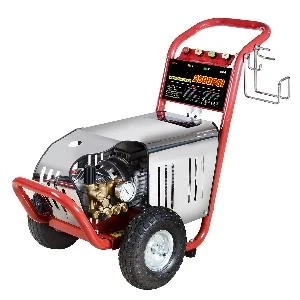A pressure washer pump is a fantastic tool for cleaning, even for household use. But it\'s important to remember to keep up with the maintenance of the pressure washer to keep it running smoothly and efficiently.
If you are looking to buy a pressure washer, you might want to consider maintenance tips to keep your equipment in good condition. If you plan to use it frequently, it is highly recommended that you read the manual first before using it. This will help you know its limits and how to take care of your equipment. The most important part of a pressure washer is the pump. This is because it provides an uninterrupted water supply to the spray gun. Keeping it clean can prevent dirt from entering the pump. It is best to check the water supply hoses and the spray gun to see if there are leaks.
We have enlisted below a few tips for pressure washer maintenance to help you keep your machine in top shape and working well –
Inalsa High Pressure Washer Power Shot 2100W
Tips for Pressure Washer Pump Maintenance
1. Use a pump protector product for durability
Leaving water in the pump can cause mineral build-up and corrosion, which destroys the seals and pistons. So it’s a good idea to flush the pump after each use—it’s a quick job. Purchase a can of pump lubricant/antifreeze solution. Attach the garden hose adapter to the pump inlet and press the trigger until foamy liquid shoots out the other port. That means the pump is entirely lubricated and freeze-protected. After each use, flush: Connect the garden hose port to the lubricant can. For about two seconds, press the trigger until water and lubricating oil shoot out the other port.
2. Prepare the engine for next season (to store it well)
The small engines used in housing pressure washers have a finite lifespan (sometimes less than 200 hours). However, by following these simple pre-storage tips, you can extend the engine’s life. Even if the crankcase oil has only been used for a few hours, drain it and replace it with fresh oil. Then, operate the engine for a few minutes to cover all the internal parts with new anti-corrosion additives and clean oil. Whether running the machine dry or filling the tank, always start with fresh gas treated with a fresh fuel stabilizer. Start the engine and let the treated gas fill the carburetor for a few minutes. The tank should then be drained and run dry.
3. Use a hose extension to improve the high pressure washer
A 25-foot hose is standard on most residential pressure washers. That means you’ll have to lug the machine up the stairs to wash your deck or turn off the engine frequently so you can move the device as you work. Use a 50-foot extension hose to solve this problem, and keep the pressure washer in one location. The additional hose will reduce pressure and volume slightly, but you’ll still have enough power to clean most surfaces.
4. Lubricate pressure washer hose connectors
Dry O-rings in pressure washer hose connectors can twist and tear as you connect them, causing them to fail. Buy a small silicone plumber\'s grease container instead of regular oil because regular oil washes away when wet. It does not wash off and is suitable for all O-ring materials. Tape the container to your machine so you can access it at all times. Then, every five uses or whenever the O-rings appear to be dry, reapply a new layer.
5.Only use pressure washer pump cleaning fluids
Pressure washer soap dispensers are only meant with specific pressure washer fluids. Degreasers, heavy-duty cleaning liquids, bleach, and acids can all wreak havoc on the pump. Even if the soap is rated for use with a pressure washer pump, make sure it\'s the suitable soap for the job—the soaps aren\'t interchangeable. Concrete soap, for example, will not clean concrete, and the chemicals in concrete soap will discolour alloy wheels and bright metal trim pieces if used to wash your car or truck. Allow the soap to sit for the recommended time before rinsing, and scrub heavily soiled surfaces with a brush.
Finally, never leave the soap in the dispenser when storing the machine; it can dry into crystals and damage the pump. After each use, flush the soap dispenser and pull the gun trigger to clear the pump before shutting it down.
6. Pressure washer security
Keep the pressure washer unit away from structures. Hot exhaust can cause vinyl siding to melt and fires to start. When cleaning the garage floor, never use a gas-powered pressure washer pump. To avoid carbon monoxide poisoning, move it at least 5 feet away from the house. To remove caulk around windows, never use a high pressure washer spray. Water can be forced behind siding by the stream, causing extensive water damage.
Which are a few durable pressure washer pumps?
This Ingco High Pressure Washer comes with an aluminum wire motor and auto-stop system. Its 1200W input power and 3-meter hose length make it an ideal product for any high pressure cleaning.
For any outdoor cleaning, we recommend the Akari Portable Car Pressure Washer. It’s one of the most versatile & innovative pressure washer pumps available.
The Dongcheng Pressure Washer comes with a 1600W input power and a single hose mechanism. Its built quality and performance will give efficient results.
Conclusion
A pressure washer pump is integral to the operation of any pressure washer. If the pump is allowed to get clogged with dirt and debris, it will not be able to pump water out of the pressure washer at a sufficient rate to provide a steady stream to the spray gun.
For any cleaning purposes, you need a durable and high-performing pressure washer. Check out industrybuying.com for industrial goods across multiple sectors. Avail of bulk discounts and additional discounts up to 70% off site-wide!
0



